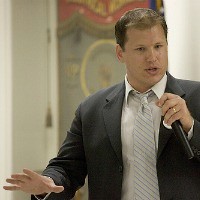 Today’s guest post is written by Adriel Hampton.
Today’s guest post is written by Adriel Hampton.
Forget how many followers someone has, how many likes they have, and even their Klout score.
The first thing to look at when making a snap judgement about someone on Twitter is how many lists they are on.
Twitter introduced lists two years ago and their effective use separates amateurs from the pros.
The thing is, any former real state agent (<ducking> – some of my best friends are realtors) can amass tens of thousands of followers, but in general, a person who’s been listed 100 or more times has achieved significant credibility.
A ratio of one list to 10 followers is gold. Most spammer-type “social media experts” on Twitter don’t bother with lists, which are significantly more work to game than follower counts.
So, what are Twitter lists?
Twitter lets you create up to 20 lists. You can have up to 500 people on each list. You can then view tweets from people on the lists as filtered streams.
We’ll go back to how to analyze credibility using lists in a second.
First, more ways to use Twitter lists:
- Take Twitter relationships to the next level. A follow is like a nod in passing, a listing is a full “hello!”
- Find and categorize locals using LocaFollow and Twellow, add them to geographic lists.
- Recognize business partners and guests on your blogs, podcasts, and other media outlets (I list all guests of my Gov 2.0 Radio podcast).
- Publicly share affinities.
- Use topical lists to help quickly find related Twitter accounts and to help friends get started (I have lists such as “Progressives without borders,” “Global Gov 2.0” and “Good Twitter contacts” for these).
- Add informational tags to people (I have three lists full of folks I first connected with on Empire Avenue, and a couple “Handshakes” lists for folks I’ve met offline).
Back to credibility.
There are all kinds of tricks for juicing your follower counts and ratio of following to followers. These are used by everyone from spammers to big marketing names.
Getting on a lot of lists means people have taken the time to give you some public recognition. And while there are a few services that add people to random lists (to my great consternation), in general, listings are deeply meaningful.
Scrolling through the lists someone is on gives you rich semantic cues as to what others think about them and what they do.
I’m on a bunch of Gov 2.0, political, media and tech lists. Someone else might have a bunch of peers who’ve listed them as marketers, or salespeople, or PR pros. One of my lists acknowledges people I think are social media pros.
Lists also help you to find new people to follow from whom you can glean information. If you were a gov IT vendor, how much would you pay for a list of a bunch of gov CTOs, and access to their daily thoughts? You don’t need to – I have a public list of gov CIOs and CTOs.
If you’ve not been using lists, don’t despair. Heck, you can poach from mine. And sites such as Formulists help you to find great lists on any topic you can imagine.
If you already have thousands of people in your network, don’t spend days going through them – just come up with a simple strategy for using lists in your interactions. Set up a few, and begin adding people and new lists as you interact with folks and evaluate new followers.
Trust me, you’ll be glad you did.
Adriel Hamptonis chief organizer at NationBuilder, a software platform for organizing. He is also founder and producer of the Gov 2.0 Radio podcast and a prolific tweeter.